小学英语阅读课表格式教案模板
- 格式:docx
- 大小:15.10 KB
- 文档页数:1
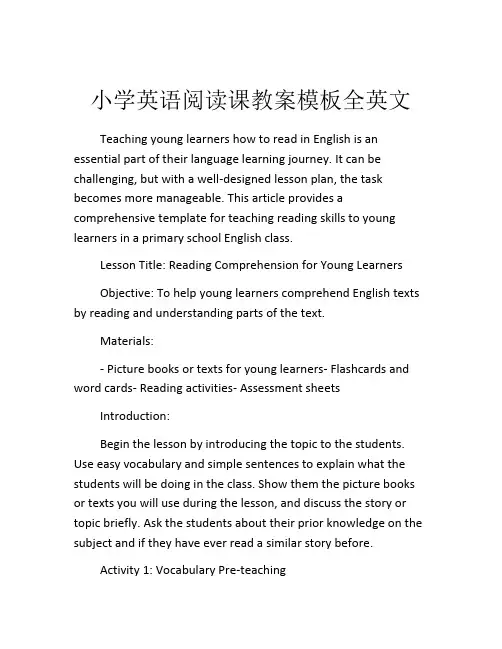
小学英语阅读课教案模板全英文Teaching young learners how to read in English is an essential part of their language learning journey. It can be challenging, but with a well-designed lesson plan, the task becomes more manageable. This article provides a comprehensive template for teaching reading skills to young learners in a primary school English class.Lesson Title: Reading Comprehension for Young LearnersObjective: To help young learners comprehend English texts by reading and understanding parts of the text.Materials:- Picture books or texts for young learners- Flashcards and word cards- Reading activities- Assessment sheetsIntroduction:Begin the lesson by introducing the topic to the students. Use easy vocabulary and simple sentences to explain what the students will be doing in the class. Show them the picture books or texts you will use during the lesson, and discuss the story or topic briefly. Ask the students about their prior knowledge on the subject and if they have ever read a similar story before.Activity 1: Vocabulary Pre-teachingIntroduce the students to new vocabulary words found in the text they will be reading. Use flashcards or word cards to facilitate this activity. Pronounce each word and ask the students to repeat it after you. Then, explain the meaning of each word and provide examples of how they are used. Drill the vocabulary words with the students till they are familiar with them.Activity 2: Reading AloudAsk the students to read the text aloud with you. Demonstrate how to pronounce each word correctly and encourage the students to follow your intonation. You can read some parts of the text first, then, ask the students to read alone, or in pairs. Ensure that everyone participates in reading the text.Activity 3: Comprehension QuestionsAsk the students comprehension questions based on the text. These questions should test their understanding of the story, what they have read and make sure to use vocabulary words that they learned earlier. For example;- What is the story about?- What happened in the story?- Who are the characters in the story? - Where did the story happen?- What did the characters do in the story?- What happened at the end of the story?Activity 4: Independent ReadingAllow students to read the text again on their own, either silently or out loud. Give the students a time frame for readingthe text. Circulate around the classroom and check their individual progress, addressing any queries or difficulties they have.Assessment:Assess each student's level of comprehension by having them complete an assessment sheet. The assessment sheet should be designed to test whether students have understood the story and its vocabulary words.Conclusion:Provide feedback to the students on their performance and encourage their progress. Play games or activities to reinforce their learning and make the class enjoyable and fun. End the class with a summary and reminder of the vocabulary words learned in the lesson.In summary, teaching young learners English reading comprehension involves ensuring that the students are engaged, taking steps to build their vocabulary and ensure they understand what they have read. Use specific teaching methods to activate their critical thinking, and create an environment that is interactive and fun. With this template lesson plan, you can strengthen the reading skills of young learners, prepare them for future learning, and set them on a path to mastering the English language.。
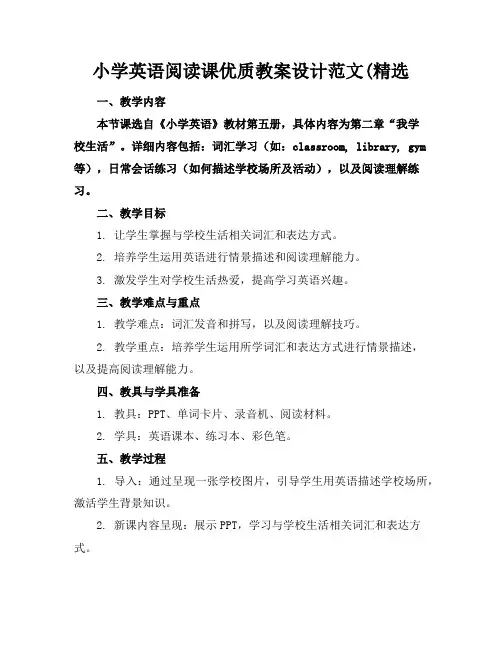
小学英语阅读课优质教案设计范文(精选一、教学内容本节课选自《小学英语》教材第五册,具体内容为第二章“我学校生活”。
详细内容包括:词汇学习(如:classroom, library, gym 等),日常会话练习(如何描述学校场所及活动),以及阅读理解练习。
二、教学目标1. 让学生掌握与学校生活相关词汇和表达方式。
2. 培养学生运用英语进行情景描述和阅读理解能力。
3. 激发学生对学校生活热爱,提高学习英语兴趣。
三、教学难点与重点1. 教学难点:词汇发音和拼写,以及阅读理解技巧。
2. 教学重点:培养学生运用所学词汇和表达方式进行情景描述,以及提高阅读理解能力。
四、教具与学具准备1. 教具:PPT、单词卡片、录音机、阅读材料。
2. 学具:英语课本、练习本、彩色笔。
五、教学过程1. 导入:通过呈现一张学校图片,引导学生用英语描述学校场所,激活学生背景知识。
2. 新课内容呈现:展示PPT,学习与学校生活相关词汇和表达方式。
3. 例题讲解:选取一篇描述学校生活短文,讲解阅读理解技巧,引导学生进行阅读。
4. 随堂练习:让学生运用所学词汇和表达方式,进行情景描述和阅读理解练习。
5. 小组活动:分组进行角色扮演,模拟学校生活场景,巩固所学知识。
六、板书设计1. 词汇:用不同颜色粉笔书写新学词汇,突出重点。
2. 阅读理解技巧:列出关键信息,展示解题步骤。
七、作业设计1. 作业题目:a. 抄写新学词汇,并写出中文意思。
b. 根据所学内容,编写一段关于学校生活短文。
c. 阅读一篇关于学校活动文章,回答相关问题。
答案:a. 略b. 略c. 略八、课后反思及拓展延伸1. 课后反思:关注学生在课堂上表现,解他们对词汇和阅读理解掌握程度,及时调整教学方法。
2. 拓展延伸:鼓励学生课后观察学校生活,用英语记录有趣事情,提高英语实际运用能力。
同时,推荐学生阅读更多关于学校生活英文文章,丰富词汇量和阅读经验。
重点和难点解析:一、教学内容选择与编排在选择教学内容时,我特别关注与学校生活紧密相关话题,因为这是学生熟悉且感兴趣。
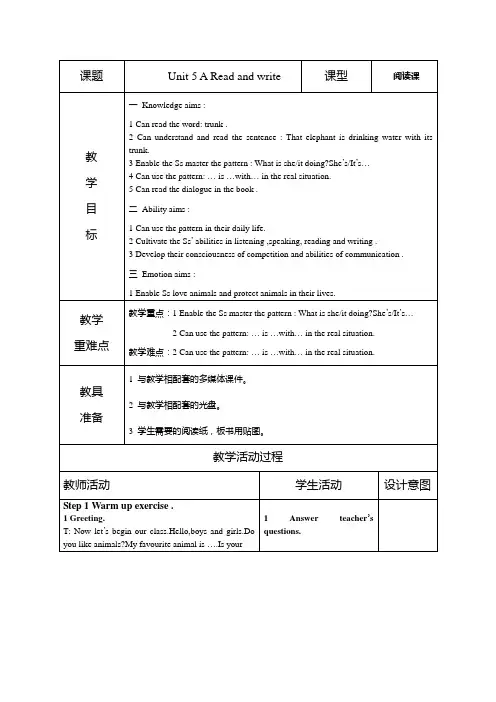
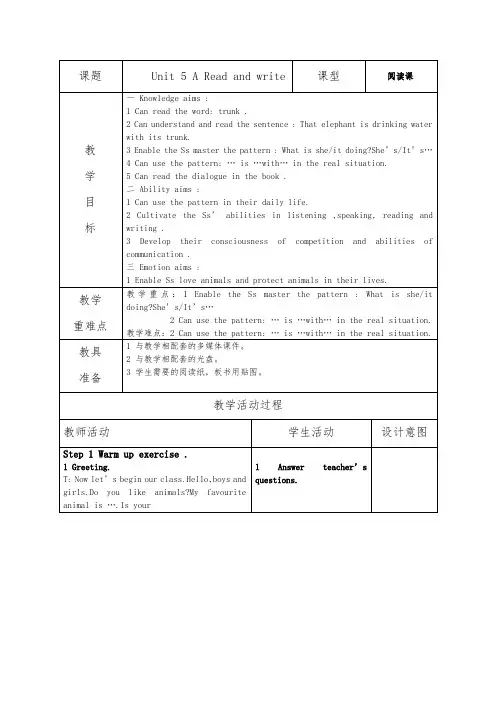

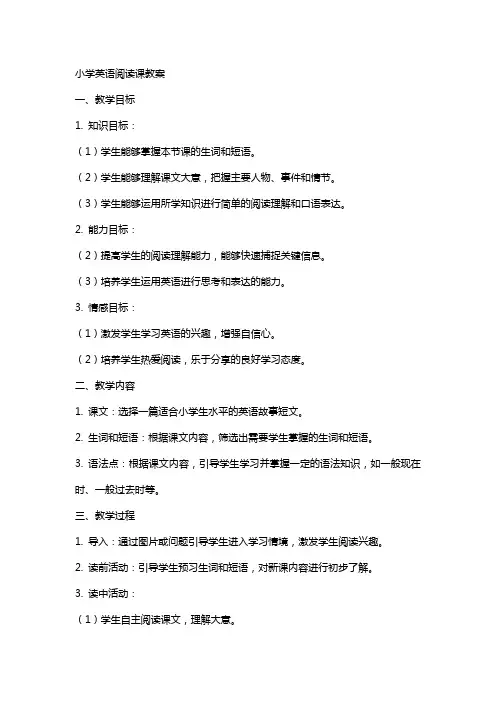
小学英语阅读课教案一、教学目标1. 知识目标:(1)学生能够掌握本节课的生词和短语。
(2)学生能够理解课文大意,把握主要人物、事件和情节。
(3)学生能够运用所学知识进行简单的阅读理解和口语表达。
2. 能力目标:(2)提高学生的阅读理解能力,能够快速捕捉关键信息。
(3)培养学生运用英语进行思考和表达的能力。
3. 情感目标:(1)激发学生学习英语的兴趣,增强自信心。
(2)培养学生热爱阅读,乐于分享的良好学习态度。
二、教学内容1. 课文:选择一篇适合小学生水平的英语故事短文。
2. 生词和短语:根据课文内容,筛选出需要学生掌握的生词和短语。
3. 语法点:根据课文内容,引导学生学习并掌握一定的语法知识,如一般现在时、一般过去时等。
三、教学过程1. 导入:通过图片或问题引导学生进入学习情境,激发学生阅读兴趣。
2. 读前活动:引导学生预习生词和短语,对新课内容进行初步了解。
3. 读中活动:(1)学生自主阅读课文,理解大意。
(2)教师提问,检查学生对课文的理解程度。
(3)学生分角色朗读课文,模仿语音语调。
4. 读后活动:(1)学生进行小组讨论,分享阅读心得。
(2)教师组织词汇游戏或语法练习,巩固所学知识。
(3)学生进行口语表达,运用所学知识进行交流。
四、教学评价1. 课堂参与度:观察学生在课堂上的参与情况,是否积极回答问题、参与讨论等。
2. 阅读理解:通过课后练习或课堂提问,检查学生对课文内容的理解程度。
3. 口语表达:通过小组讨论、角色扮演等方式,评估学生的口语表达能力和运用英语进行思考的能力。
五、教学资源1. 教材:选用适合小学生水平的英语阅读教材。
2. 多媒体教学设备:如投影仪、电脑等,用于展示课文、生词和短语等。
3. 教学挂图、图片等:用于辅助教学,增加学生兴趣。
4. 录音机、磁带或音频文件:用于播放课文朗读,帮助学生模仿语音语调。
六、教学步骤1. 步骤一:导入(5分钟)教师通过展示与课文主题相关的图片或视频,引导学生谈论相关话题,激发学生的阅读兴趣。
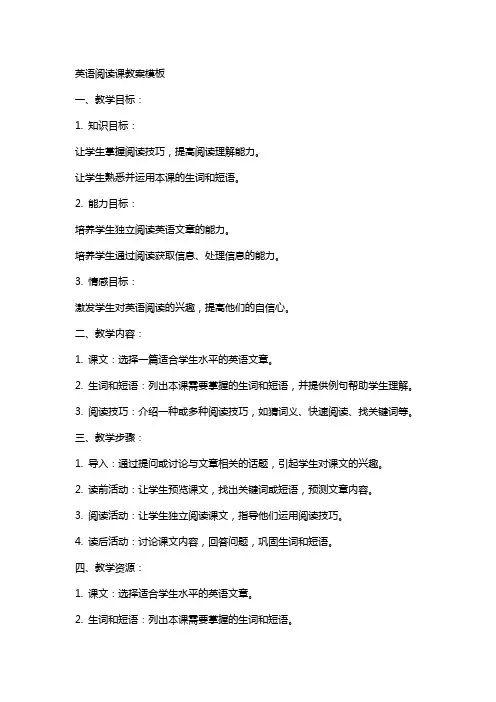
英语阅读课教案模板一、教学目标:1. 知识目标:让学生掌握阅读技巧,提高阅读理解能力。
让学生熟悉并运用本课的生词和短语。
2. 能力目标:培养学生独立阅读英语文章的能力。
培养学生通过阅读获取信息、处理信息的能力。
3. 情感目标:激发学生对英语阅读的兴趣,提高他们的自信心。
二、教学内容:1. 课文:选择一篇适合学生水平的英语文章。
2. 生词和短语:列出本课需要掌握的生词和短语,并提供例句帮助学生理解。
3. 阅读技巧:介绍一种或多种阅读技巧,如猜词义、快速阅读、找关键词等。
三、教学步骤:1. 导入:通过提问或讨论与文章相关的话题,引起学生对课文的兴趣。
2. 读前活动:让学生预览课文,找出关键词或短语,预测文章内容。
3. 阅读活动:让学生独立阅读课文,指导他们运用阅读技巧。
4. 读后活动:讨论课文内容,回答问题,巩固生词和短语。
四、教学资源:1. 课文:选择适合学生水平的英语文章。
2. 生词和短语:列出本课需要掌握的生词和短语。
3. 阅读技巧:提供相关阅读技巧的资料。
五、教学评价:1. 课堂参与度:观察学生在课堂上的积极参与情况。
2. 阅读理解能力:通过课后作业或小测验评估学生的阅读理解能力。
3. 学习效果:通过课后反馈或考试评估学生的学习效果。
六、教学策略:1. 任务型教学法:通过完成各种阅读任务,激发学生的学习兴趣,提高他们的阅读理解能力。
2. 交互式教学法:引导学生参与课堂讨论,培养他们的思维能力和语言表达能力。
3. 差异化教学法:针对不同学生的学习水平和需求,提供适当的阅读材料和辅导。
七、教学重点与难点:1. 教学重点:培养学生独立阅读英语文章的能力,提高他们的阅读理解能力。
2. 教学难点:掌握阅读技巧,正确理解和运用本课的生词和短语。
八、教学延伸:1. 拓展阅读:推荐与课文主题相关的英语文章,让学生进行拓展阅读。
2. 小组活动:组织学生进行小组讨论,分享阅读心得和经验。
3. 家长参与:鼓励家长参与孩子的阅读学习,提供适当的辅导和支持。
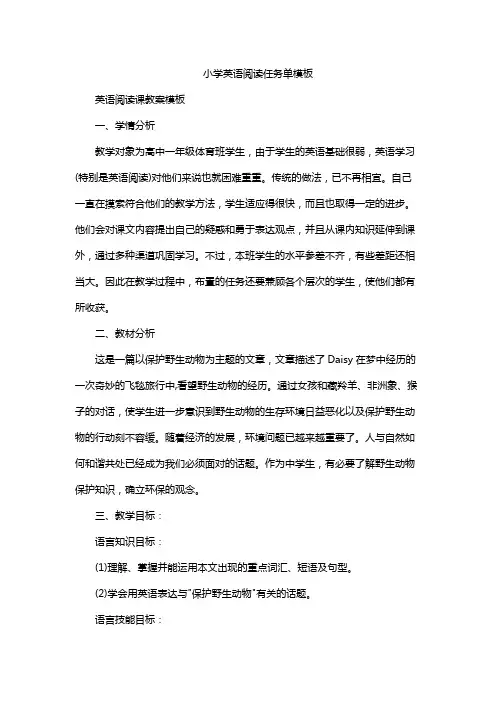
小学英语阅读任务单模板英语阅读课教案模板一、学情分析教学对象为高中一年级体育班学生,由于学生的英语基础很弱,英语学习(特别是英语阅读)对他们来说也就困难重重。
传统的做法,已不再相宜。
自己一直在摸索符合他们的教学方法,学生适应得很快,而且也取得一定的进步。
他们会对课文内容提出自己的疑惑和勇于表达观点,并且从课内知识延伸到课外,通过多种渠道巩固学习。
不过,本班学生的水平参差不齐,有些差距还相当大。
因此在教学过程中,布置的任务还要兼顾各个层次的学生,使他们都有所收获。
二、教材分析这是一篇以保护野生动物为主题的文章,文章描述了Daisy在梦中经历的一次奇妙的飞毯旅行中,看望野生动物的经历。
通过女孩和藏羚羊、非洲象、猴子的对话,使学生进一步意识到野生动物的生存环境日益恶化以及保护野生动物的行动刻不容缓。
随着经济的发展,环境问题已越来越重要了。
人与自然如何和谐共处已经成为我们必须面对的话题。
作为中学生,有必要了解野生动物保护知识,确立环保的观念。
三、教学目标:语言知识目标:(1)理解、掌握并能运用本文出现的重点词汇、短语及句型。
(2)学会用英语表达与"保护野生动物"有关的话题。
语言技能目标:(1)能继续巩固速读、概括、比较等阅读技能,获取有关"野生动物保护"的信息,培养其对所获取信息进行分析、处理和解决问题的能力。
(2)能根据野生动物话题有条理的做简短发言、对话等活动,培养学生用英语进行思维和表达的能力;为学生进一步学习和发展创造必要的条件。
情感目标:(1)激发并提高学生学习英语的兴趣;体现课堂教学主体者的身份,使其积极主动参与教学各环节,成为学习的主人;培养学生的个性和创造能力。
(2)通过小组合作学习,能与同伴用英语进行积极地交流,发展与人沟通和合作的能力;培养学生的合作意识,(3)能意识到野生动物保护和环境保护的重要性、紧迫性以及对人类生存和发展的非凡意义。
能积极热爱生命,关注自然,关注人与自然的和谐,树立保护野生动物的责任感。
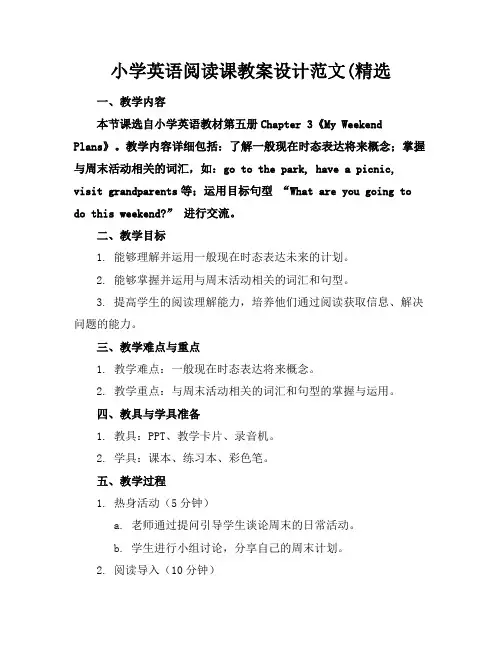
小学英语阅读课教案设计范文(精选一、教学内容本节课选自小学英语教材第五册Chapter 3《My Weekend Plans》。
教学内容详细包括:了解一般现在时态表达将来概念;掌握与周末活动相关的词汇,如:go to the park, have a picnic, visit grandparents等;运用目标句型“What are you going to do this weekend?” 进行交流。
二、教学目标1. 能够理解并运用一般现在时态表达未来的计划。
2. 能够掌握并运用与周末活动相关的词汇和句型。
3. 提高学生的阅读理解能力,培养他们通过阅读获取信息、解决问题的能力。
三、教学难点与重点1. 教学难点:一般现在时态表达将来概念。
2. 教学重点:与周末活动相关的词汇和句型的掌握与运用。
四、教具与学具准备1. 教具:PPT、教学卡片、录音机。
2. 学具:课本、练习本、彩色笔。
五、教学过程1. 热身活动(5分钟)a. 老师通过提问引导学生谈论周末的日常活动。
b. 学生进行小组讨论,分享自己的周末计划。
2. 阅读导入(10分钟)a. 老师展示PPT,呈现课文情景。
b. 学生观看PPT,预测文章内容。
3. 阅读理解(15分钟)a. 学生自主阅读课文,理解文章大意。
b. 老师提问,检查学生对文章的理解程度。
4. 语法讲解(10分钟)a. 老师讲解一般现在时态表达将来概念的用法。
b. 学生通过例句,理解并运用该语法点。
5. 例题讲解与随堂练习(15分钟)a. 老师讲解例题,指导学生进行练习。
b. 学生进行随堂练习,巩固所学知识。
6. 小组活动(5分钟)a. 学生分组,用目标句型讨论周末计划。
b. 各小组展示讨论成果,全班分享。
b. 学生提出疑问,老师解答。
六、板书设计1. 课文My Weekend Plans2. 重点词汇:go to the park, have a picnic, visit grandparents等。
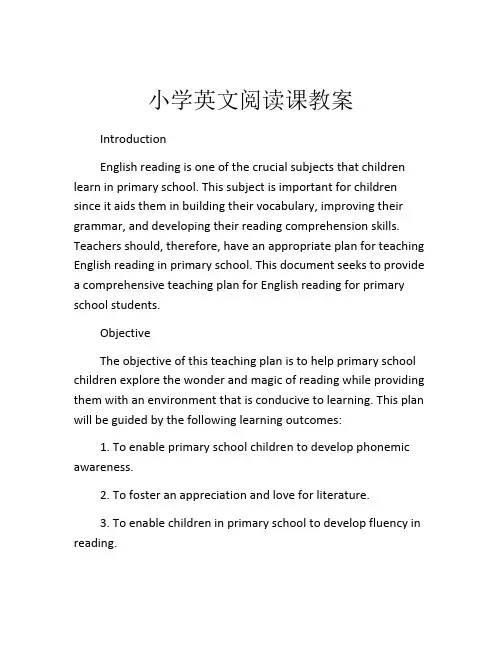
小学英文阅读课教案IntroductionEnglish reading is one of the crucial subjects that children learn in primary school. This subject is important for children since it aids them in building their vocabulary, improving their grammar, and developing their reading comprehension skills. Teachers should, therefore, have an appropriate plan for teaching English reading in primary school. This document seeks to provide a comprehensive teaching plan for English reading for primary school students.ObjectiveThe objective of this teaching plan is to help primary school children explore the wonder and magic of reading while providing them with an environment that is conducive to learning. This plan will be guided by the following learning outcomes:1. To enable primary school children to develop phonemic awareness.2. To foster an appreciation and love for literature.3. To enable children in primary school to develop fluency in reading.4. To improve the reading comprehension skills of primary school students.5. To encourage primary school children to develop a lifelong love for reading.Lesson PlanThis teaching plan entails nine different lessons that will be taught over the course of the academic year. The lessons will be age-appropriate, hands-on, interactive, and will incorporate forms of technology such as a documentary video about animals, audio and video recordings, among others. The lessons are as follows:Lesson 1: Introduction to phonics.This lesson will help primary school children learn the basic phonetic rules of English. Teachers can use analytical and synthetic phonics activities such as phonics flashcards, alphabet cards, and simple word puzzles.Lesson 2: Building vocabularyThis lesson focuses on the importance of developing a strong vocabulary, which is a crucial piece of language learning. Teachers can use picture books, word games and vocabulary organizers.Lesson 3: Reading Aloud.In this lesson, the teacher will read a story out loud to the class in an animated and exciting way. This lesson will help foster an appreciation and love for literature.Lesson 4: Silent ReadingThis lesson involves silent reading and encourages children to read independently from books. Students can participate in a reading competition or reading challenge.Lesson 5: Fluency PracticeThe lesson will focus on developing fluency in reading. Teachers can use oral reading games, Reader's Theater, and choral reading activities.Lesson 6: Reading ComprehensionThis lesson will help primary school children develop reading comprehension skills. Teachers can use graphic organizers such as "Five Ws and H," "Main Idea," and "Sequence Chain".Lesson 7: Poetry ReadingThis lesson will encourage children in primary school to read and appreciate poetry. Teachers can use poems that areage-appropriate and appropriate for this level of learning.Lesson 8: Documentary Video ReadingThis lesson will incorporate technology by using documentary videos. Students can watch a documentary video about animals, for example, and then write a reading summary or present a poster on the documentary.Lesson 9: Final AssessmentIn the final lesson, students will be evaluated on their progress in the course. The assessment can be structured to incorporate all of the learning objectives of the course.ConclusionThis teaching plan will provide students with a quality English reading program. English reading enhances the children's intellect, creativity, and overall well-being. They develop imaginative and analytical thinking abilities that they will use throughout their life. The outcomes of the plan are achievable and will assist children in developing a lifelong love for reading. Ultimately, children at this stage of learning are more receptive to reading, and it’s a teacher's duty to help them in this journey.。
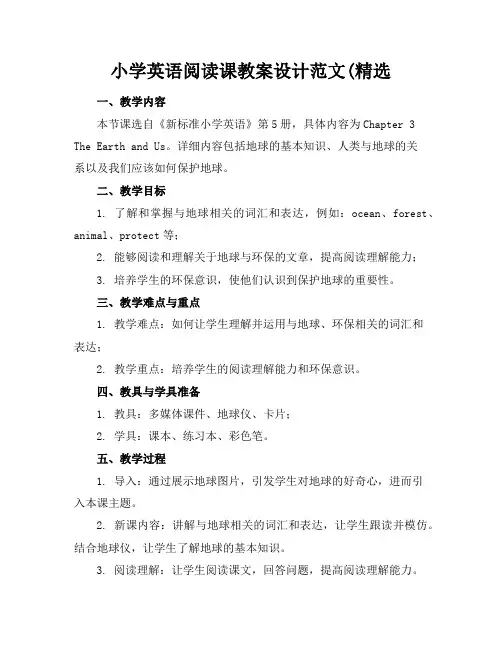
小学英语阅读课教案设计范文(精选一、教学内容本节课选自《新标准小学英语》第5册,具体内容为Chapter 3 The Earth and Us。
详细内容包括地球的基本知识、人类与地球的关系以及我们应该如何保护地球。
二、教学目标1. 了解和掌握与地球相关的词汇和表达,例如:ocean、forest、animal、protect等;2. 能够阅读和理解关于地球与环保的文章,提高阅读理解能力;3. 培养学生的环保意识,使他们认识到保护地球的重要性。
三、教学难点与重点1. 教学难点:如何让学生理解并运用与地球、环保相关的词汇和表达;2. 教学重点:培养学生的阅读理解能力和环保意识。
四、教具与学具准备1. 教具:多媒体课件、地球仪、卡片;2. 学具:课本、练习本、彩色笔。
五、教学过程1. 导入:通过展示地球图片,引发学生对地球的好奇心,进而引入本课主题。
2. 新课内容:讲解与地球相关的词汇和表达,让学生跟读并模仿。
结合地球仪,让学生了解地球的基本知识。
3. 阅读理解:让学生阅读课文,回答问题,提高阅读理解能力。
4. 例题讲解:针对阅读内容,设计相关问题,引导学生运用所学知识解决问题。
5. 随堂练习:让学生根据所学内容,进行小组讨论,完成练习题。
六、板书设计1. The Earth and Us2. 主要词汇:ocean、forest、animal、protect等;3. 重点句型:We need to protect the Earth.、What can wedo to protect the Earth? 等;4. 环保标语:Save the Earth, Save Ourselves.七、作业设计1. 作业题目:a. Why is the Earth important to us?b. What can we do to protect the Earth?(2)运用所学词汇和句型,写一篇关于保护地球的短文。
小学英语阅读课教案一、教学目标1. 知识目标:(1)学生能够掌握本节课的生词和短语。
(2)学生能够理解课文大意,正确朗读课文。
(3)学生能够运用所学知识进行简单的阅读理解。
2. 能力目标:(1)学生能够提高阅读理解能力。
(2)学生能够提高词汇量和语言表达能力。
(3)学生能够学会查找和运用相关信息。
3. 情感目标:(1)激发学生学习英语的兴趣。
(2)培养学生的团队合作精神。
(3)提高学生的自信心和自主学习能力。
二、教学内容1. 课文内容:选取一篇适合小学生的英语阅读材料,如童话故事、生活故事等。
2. 生词和短语:根据课文内容,选取一定数量的生词和短语进行学习。
3. 语法点:根据课文内容,讲解和练习其中的语法点。
三、教学方法1. 任务型教学法:通过完成各种任务,激发学生的学习兴趣,培养学生的实践能力。
2. 情境教学法:创设真实的语言环境,让学生在实践中学习英语。
3. 合作学习法:引导学生进行小组讨论和合作,提高学生的团队协作能力。
四、教学步骤1. 热身活动(5分钟):通过歌曲、游戏等方式,引导学生进入英语学习状态。
2. 导入新课(10分钟):介绍本节课的学习内容,激发学生的学习兴趣。
3. 自主学习(15分钟):学生自主阅读课文,学习生词和短语,理解课文大意。
4. 课堂讲解(20分钟):讲解课文中的语法点,引导学生进行相关练习。
5. 小组活动(15分钟):学生分组进行讨论和合作,完成相关任务。
6. 总结反馈(5分钟):对学生的学习情况进行总结,给予表扬和鼓励。
五、课后作业1. 复习课文内容,巩固所学知识。
2. 完成课后练习题,提高阅读理解能力。
3. 收集相关资料,进行拓展学习。
4. 准备下一节课的课堂展示。
六、教学评价1. 课堂表现:观察学生在课堂上的参与程度、发言情况等,了解学生的学习状态。
2. 课后作业:检查学生的课后作业完成情况,评估学生的学习效果。
3. 单元测试:进行单元测试,了解学生对课文内容、语法点和阅读理解的掌握程度。
英语阅读课教案(5篇范文)第一篇:英语阅读课教案英语阅读课教案模板一、反馈:1.主要是上节课的练习易出错的地方。
want sb.to do, It’s good for sth , be active2.上节的重点知识回顾。
What do you usually do on weekends? I usually play soccer?How often do you watch TV? I watch TV twice a week.二、教学重难点: 1.语法.一般现在时:时间状语:always, usually, often, sometimes, hardly ever, once a week, twice a week, three times a week 2.基本句型: What do you usually do on weekends? I usually play soccer?How often do you watch TV? I watch TV twice a week.)3.长短句子的理解。
1.My health lifestyle helps me get good grades2.Good food and exercise help me to study better.help sb to do sth help sb do sth, help sb with sthnever, 3.I try to eat a lot of vegetables.try to do sth三、突破方法:英语阅读三遍阅读法:(ppt)第一遍学生快读,老师提出1问题。
Q: How often does she eat fruit and drink milk? 第二遍学生细读,老师提4问题。
1.What does she try to eat? 2.How often does she drink coffee? 3.How many hours does she sleep every night?4.What helps her get good grades? 第三遍学生朗读及学生自己提出问题,老师解答疑难。
小学英语阅读教案计划课时:1课时年级:小学四年级教学目标:1. 能正确朗读课文,理解课文大意。
2. 能运用所学词汇和句型进行简单的交流。
3. 培养学生的阅读兴趣,提高阅读能力。
4. 引导学生学会关爱动物,与动物和谐相处。
教学内容:1. 课文:《The Cat and the Mouse》2. 词汇:cat, mouse, run, chase, hole, hide等。
3. 句型:What's this? It's a/an... How old is it? It's... years old.教学过程:Step 1: Lead-in(5分钟)1. 教师展示一张猫和老鼠的图片,引导学生说出它们的英文名称。
2. 教师询问学生是否知道猫和老鼠的特点,引导学生用英语进行回答。
Step 2: Pre-reading(5分钟)1. 教师给出课文标题《The Cat and the Mouse》,引导学生猜测课文内容。
2. 教师快速浏览课文,引导学生关注关键词汇。
Step 3: While-reading(10分钟)1. 教师引导学生跟随课文朗读,注意语音语调。
2. 教师暂停课文,针对关键词汇进行讲解和练习。
3. 教师引导学生回答课文内容相关问题,检查学生对课文的理解。
Step 4: Post-reading(10分钟)1. 教师组织学生进行角色扮演,表演课文故事。
2. 教师引导学生运用所学词汇和句型进行小组交流,讨论自己喜欢的动物。
Step 5: Summary(5分钟)1. 教师引导学生总结本节课所学内容。
2. 教师强调关爱动物,与动物和谐相处的重要性。
Step 6: Homework(5分钟)1. 学生回家后,和家长一起寻找其他关于猫和老鼠的故事,分享给家长。
2. 学生和家长一起完成课后练习题。
教学评价:1. 课后收集学生的角色扮演视频,观察学生的口语表达和表演能力。
2. 检查课后练习题完成情况,了解学生的学习效果。
小学英语阅读课精品教案设计范文(精选一、教学内容本节课选自《小学英语》教材第五册,具体内容包括第三章“Family and Friends”的第三节“MY Family”。
详细内容主要围绕家庭成员的介绍、日常活动和兴趣爱好,通过阅读一篇关于家庭成员的小短文,让学生掌握相关的词汇和句型,提高阅读理解能力。
二、教学目标1. 能够听懂、会说、会读家庭成员的英文单词和介绍家庭成员的简单句子。
2. 能够理解并运用一般现在时描述家庭成员的日常活动和兴趣爱好。
三、教学难点与重点重点:家庭成员的英文单词、介绍家庭成员的句子、一般现在时的运用。
难点:一般现在时的正确运用,以及如何用英文描述家庭成员的日常活动和兴趣爱好。
四、教具与学具准备1. 教具:多媒体教学设备、PPT、卡片、磁铁、录音机等。
2. 学具:教材、练习本、彩色笔等。
五、教学过程1. 导入:通过播放英文歌曲“Happy Family”,引导学生谈论自己的家庭,为新课的学习营造轻松愉快的氛围。
2. 课堂热身:教师展示家庭成员的图片,学生用英文进行快速抢答,复习巩固相关词汇。
3. 阅读前:教师提出问题,引导学生预测短文内容,激发阅读兴趣。
4. 阅读中:学生自主阅读短文,完成相应的练习题。
教师针对学生遇到的问题进行解答和指导。
5. 阅读后:教师组织学生进行小组活动,用英文介绍自己的家庭成员,并分享阅读心得。
6. 例题讲解:教师讲解一般现在时的用法,并给出例句,引导学生进行仿写练习。
7. 随堂练习:学生完成教材上的练习题,巩固所学知识。
六、板书设计1. 家庭成员英文单词:father, mother, brother, sister, grandpa, grandma等。
2. 介绍家庭成员的句子:This is my family. I have afather/mother/brother/sister…3. 一般现在时:主语 + 动词原形(第三人称单数主语 + 动词三单形式)/主语 + don't + 动词原形(第三人称单数主语 + doesn't + 动词原形)七、作业设计1. 作业题目:用英文写一篇关于自己家庭成员的短文,至少包含三个家庭成员的介绍。
小学英语阅读课教学设计模板范文全文共5篇示例,供读者参考小学英语阅读课教学设计模板范文篇1新学期要有新气象,作为教师也不例外。
为了更好的开展六年级的英语学习,加强班级同学们的英语词汇量与英语素养,给身处六年级冲刺阶段的学生们多增添一份力量。
为此,我在这新学期伊始之时,特意制定此英语教学工作计划如下:一、所带班级情景分析这学期我所带领的班级依然是xx班,此班级的班风较为活泼,在课堂互动上也较为活跃。
可是相对的是纪律方面有所缺陷,幸而对于教学并不会构成太大影响。
可是从上个学期的期末考试成绩上和一向以来的认识来看,班级内有数量较多的同学英语成绩波动较大,在英语词汇的积累与应用上还具有一些缺陷需要弥补,而这些都是我在这新的学期里需要注意和加强的'地方。
二、针对性教学方案在这个学期我除了传统上课教学下课练习模式外,还会额外添加一些英语歌曲与英语故事的教学,尝试经过趣味性的教学方式来提高班级同学们的词汇量,提高同学们对英语这一课程的理解度与自主性。
同时,因为这是小升初的考试之前的最终一学年,也是最终的冲刺准备阶段,所以我除了这些教学以外还会加强模拟考试等练习,并经过研究历年考试真题来进行有针对性的考前培训,提高学生的答题技巧以及知识运用本事。
三、个人教学工作准备1、加强自身学习研究,经过历年的考试真题来对考试可能会出现的题型题目进行一些预测,并针对预测结果来进行教学准备,以提高学生的考试本事。
2、加强与孩子们的沟通交流,明白他们学习的难点在哪里,了解自我在教学中的不足并加以改正,力求经过这种方式来让我于班级同学融为一体,共同加强学习,共同为了提高而努力奋斗。
3、一个班级中总是有成绩的高低,所以我要发挥出教师的耐心与本事来悉心教导,不抛弃任何一个学生,督促先进生,鼓励后进生,引导整个班级学习风气的前进。
在新学期里,仅靠着我一人的努力是肯定不足的,我需要设法培养起学生们的学习热情,带动起全班同学们一齐努力,自发的向上才能够在激励的竞争中考取更好的学校,理解更好的教育,在以后成为一个对祖国、对人民有贡献的栋梁之才。
小学英语阅读课教案一、教学目标:1. 知识目标:(1)学生能够掌握故事的主要情节和角色。
(2)学生能够运用已学的词汇和句型进行简单的交流。
2. 能力目标:(1)学生能够流利地朗读故事,提高阅读理解能力。
(2)学生能够通过图片和语境,正确地使用所学的词汇和句型。
3. 情感目标:(1)学生能够培养对英语阅读的兴趣。
(2)学生能够通过故事,学会分享和帮助他人。
二、教学内容:1. 教材:《小学英语阅读课教材》2. 故事主题:关于一个勇敢的小男孩帮助他的朋友解决问题。
三、教学步骤:1. 热身活动(5分钟):(1)教师带领学生唱一首英文歌曲,活跃课堂气氛。
(2)学生进行简单的英语自我介绍,互相问候。
2. 引入故事(10分钟):(1)教师展示故事封面和,激发学生的兴趣。
(2)教师简要介绍故事的主要角色和情节。
3. 学生自主阅读(10分钟):(1)学生独立阅读故事,理解大意。
(2)学生遇到生词或句型时,可以查阅课本或请教教师。
4. 分组讨论(5分钟):(1)学生分组,讨论故事中的情节和角色。
(2)每组选出一个代表,向全班分享讨论成果。
5. 教师讲解和拓展(5分钟):(1)教师针对故事中的重点词汇和句型进行讲解。
(2)教师通过实例,让学生学会运用所学知识进行实际交流。
6. 角色扮演(5分钟):(1)学生分组,选择故事中的角色进行扮演。
(2)学生用英语进行表演,其他学生观看并评价。
(2)教师布置作业,要求学生课后复习故事内容和词汇。
四、教学评价:1. 课堂参与度:观察学生在课堂上的发言和互动情况。
2. 自主学习能力:评估学生在自主阅读和完成作业时的表现。
3. 角色扮演:评价学生在表演中的语言表达和情感传递。
五、教学资源:1. 教材:《小学英语阅读课教材》2. 故事图片:用于辅助教学和激发学生兴趣。
3. 录音机或音响:用于播放英文歌曲和故事音频。
4. 投影仪:用于展示故事内容和课件。
六、教学策略:1. 互动式教学:通过问答、讨论等互动方式,激发学生的积极性和参与度。